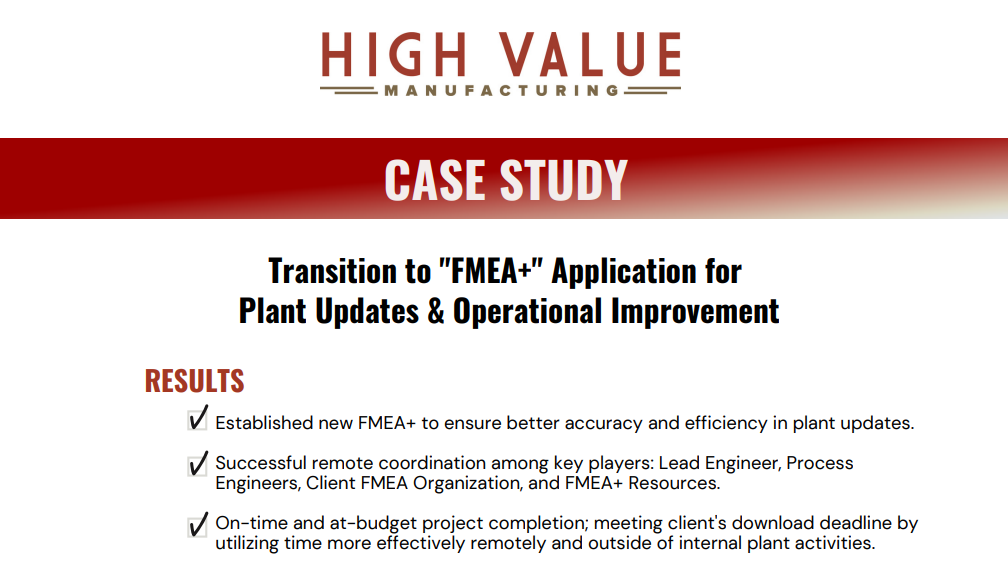By John Swanson, HVM Team Member & Owner of John Swanson Manufacturing Engineering LLC
Process Failure Mode and Effect Analysis (PFMEA) is a quality management tool that is widely used in automotive and other industries to identify and mitigate risks and failures in manufacturing processes. The availability of FMEA software applications is making continuous improvement easier for manufacturing facilities that are committed to streamlined processes.
The challenge for manufacturing managers is transitioning a static spreadsheet system to a relational database using previously unfamiliar software. High Value Manufacturing deploys highly experienced resources who are knowledgeable about Design-FMEA and PFMEA processes and are able to support process improvements when it comes to integrating new technology for enhanced efficiency in client manufacturing plants.
The Assignment
In a recent HVM resource engagement for a major automotive manufacturer, our assignment was to prepare PFMEAs and PCP (Process Control Plans) to be transitioned into a relational database application.
This project encompassed an entire manufacturing plant: a massive coordination among multiple functions, which included a total of 417 manufacturing operations PFMEAs & PCPs within:
> 5 Engine Models
> 4 Cylinder Block and Cylinder Head Types
> 3 Crankshaft Types
> 1 Engine Assembly Line
The result from this successful implementation was better accuracy and efficiency in plant updates. HVM (in collaboration with client and software representatives) met project deadlines and budget through successful remote coordination among key players.
Overcoming Challenges
There were many challenges and required tasks in this client engagement:
- Original PFMEAs and PCPs ere not up-to-date or linked to each other.
- Erroneous data from previous failed attempts to transition data to a different solution.
- Updated original PFMEAs and PCPs; expanded into numerous additional PFMEA updates.
- Created linkage points in each PFMEA and PCP to be used to transition to relational database.
- Ensured Linkage Points are unique, spelling identical, same syntax, correct data.
- Completed new system software training.
Transferability to BEV/Battery Manufacturing
In a manufacturing facility, knowledge and experience in PFMEA are critical. The relevance to Battery Electric Vehicle (BEV) assembly and battery manufacturing, where several HVM team members are currently deployed:
1) Identifying Potential Failure Modes: Just like in the general automotive industry, DFMEA and PFMEA should be applied to identify potential failure modes in BEV/Battery manufacturing processes. This can help manufacturers identify risks and take proactive measures to address them when discovering defects in battery cells, faulty electrical connections, or incorrect assembly of components.
2) Mitigating Risk: By using PFMEA, BEV manufacturers can assess the risks associated with each failure mode and prioritize their efforts to address the most critical risks considering factors such as the likelihood of the failure occurring and the severity of its potential impact. This can help manufacturers to allocate their resources more effectively and reduce the likelihood of costly failures or recalls.
3) Improving Quality: By identifying potential failure modes early in the manufacturing process, Battery manufacturers can take proactive steps to improve the quality of their products. This can help to reduce the risk of defects and recalls, which can be costly in terms of both time and money. Product quality improvements can help to improve customer loyalty, attract new business, and differentiate the manufacturer from competitors.
4) Enhancing Safety: PFMEA can help Battery manufacturers to identify safety hazards in manufacturing processes and take steps to reduce the risk of accidents and injuries. This can help to improve the safety of both workers and consumers.
5) Meeting Regulatory Requirements: PFMEA can help Battery manufacturers to comply with quality requirements, such as ISO 9001 or IATF 16949. This helps to improve customer confidence and ensure that the manufacturer is meeting the highest standards of quality.
By using this tool effectively, manufacturers can achieve greater efficiency, profitability, and customer satisfaction.
HVM is committed to applying our team’s wealth of knowledge and experience toward achieving our client’s goals.
See this Case Study summary HERE.
Did you enjoy this blog? Search our blog library for other topics of interest: https://highvaluemanufacturingconsulting.com/blog/

